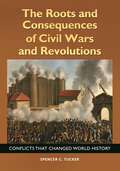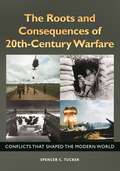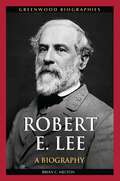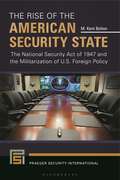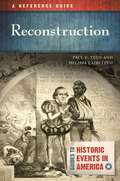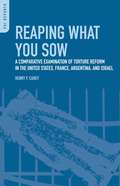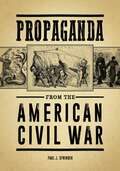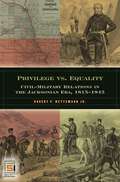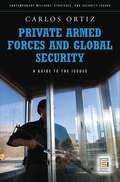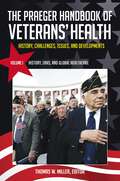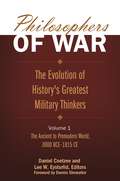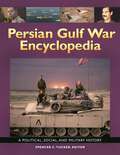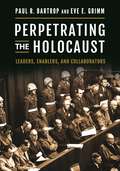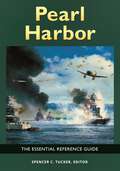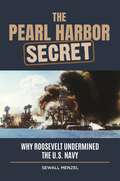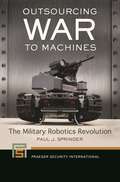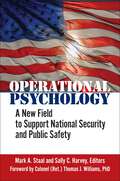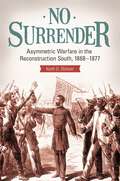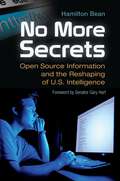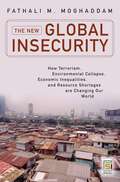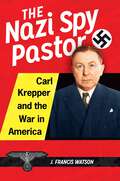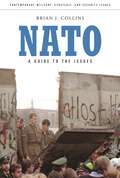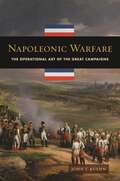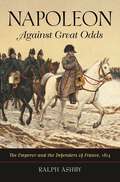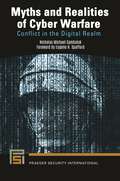- Table View
- List View
The Roots and Consequences of Civil Wars and Revolutions: Conflicts That Changed World History
by Spencer C. TuckerThis book treats 30 important civil wars and revolutions across the world, including Africa, Asia, the Americas, Europe, and the Middle East, covering a broad swath of recorded history from ancient times to the present.Human history as a whole results from social changes, technological advances, and evolutions in thinking and religion—all of which often lead to wars and conflicts. Behind each major war are myriad interrelated causes. This book examines 30 of the most significant civil wars and revolutions in recorded history, from ancient times to the modern era, identifying the origins, consequences, and subtle impacts of many of these conflicts that are still being felt today. A comprehensive overview essay as well as explanations of the causes and consequences of each conflict give readers the context needed to understand the importance of these seminal events. Additional learning tools include a detailed timeline that sets all of the key events in the conflict in the proper context, maps of several of the key battles that help readers visualize the strategies of both sides, and a lengthy bibliography that offers a wealth of options to students looking to investigate any of the conflicts further.
The Roots and Consequences of 20th-Century Warfare: Conflicts That Shaped the Modern World
by Spencer C. TuckerThis unique reference book introduces readers to the causes and effects of the 20th century's most significant conflicts—and explains how the impact of these conflicts still resonates today.The Roots and Consequences of 20th-Century Warfare: Conflicts That Shaped the Modern World introduces students to the causes and effects of the 20th century's most significant conflicts. Covering conflicts that occurred in all regions of the world, readers will gain knowledge on the causes and consequences of each conflict and become familiar with the historical context needed to understand the roots and consequences of these seminal events. The text also identifies key opponents in each conflict and illuminates the reasons why each country or group decided to fight, the scope of their involvement in the war, and the impact of the war.Reference entries on key battles are presented in chronological order, supplying engaging details on the events and people who shaped each war. The book also supplies maps of the key battles to illuminate the strategic movements of both sides of the conflict. A lengthy bibliography offers a wealth of options to readers seeking more sources of information on any of the conflicts.
Robert E. Lee: A Biography (Greenwood Biographies)
by Brian C. MeltonThis biography provides a concise, accurate, and lively account of one of the best known yet least understood figures of the Civil War, Robert E. Lee, depicting him as a human being instead of a legend, making him accessible as a person.Robert E. Lee: A Biography takes one of the best known and least understood figures of the American Civic War down from his pedestal as an iconic, legendary hero and transforms him into a human being that 21st-century readers can easily relate to. Author Brian Melton clearly separates fact from the idealized lore and fiction created after the Civil War by members of what has been termed "the Lee cult." Through the book's thorough, clear, and accessible presentation, and its inclusion of accurate historical details—for example, Lee's status as an incurable flirt—General Lee becomes a fascinating and compelling mortal man.Intended for both high school students and the general public, this biography will offer a thorough and unbiased examination of Lee's life and military career. Readers will be able to clearly trace the steps that led Lee to prominence—both before and during the Civil War—and discover how his actions helped shape the American military.
The Rise of the American Security State: The National Security Act of 1947 and the Militarization of U.S. Foreign Policy (Praeger Security International)
by M. Kent BoltonThis book examines the impact of the National Security Act of 1947, the most important foreign policy legislation that many Americans (including policymakers and academics) have never heard of.Since September 11, 2001, the White House—under both Bush and Obama—has pushed the envelope of taking the United States to war (without declarations), interrogating prisoners of war, spying on potential threats, and acting unilaterally. Why have these trends occurred? How has the apex of foreign power shifted, causing a sea change that has fueled a continual turf war between Capitol Hill and the White House? And perhaps most critically, what is America's role in the world now, and what should it be? The Rise of the American Security State: The National Security Act of 1947 and the Militarization of U.S. Foreign Policy argues that the National Security Act of 1947 and the early Cold War created a bipartisan consensus among U.S. policymakers that spanned several administrations. The result of this consensus and the National Security Act was the creation of permanent institutions: the permanent Defense Department with a secretary of defense; the intelligence community, which has grown to 17 agencies; and significantly, the National Security Council inside the presidency. Collectively, these three developments have led to the militarization of U.S. foreign policy. Readers will grasp how concepts and strategies that were in their infancy during the Cold War era have persisted and continued to affect today's U.S. foreign policy.
Reconstruction: A Reference Guide (Guides to Historic Events in America)
by Paul E. Teed Melissa Ladd TeedProviding an exciting narrative of Reconstruction based on current scholarship, historical sources, as well as interpretive essays on special topics, this book offers real insight into a controversial and critical period in American history.Reconstruction: A Reference Guide covers the entire period of Reconstruction (1863–1877) with a special emphasis on the struggle for social and political equality in the post-Civil War South. The book's analytical essays, selection of primary documents, and biographies of key participants give readers an understanding of social, political, and economic changes that occurred during this important period as well as provide opportunities to explore more specific issues and debates. Synthesizing and building on the work of recent scholars, the book documents how the central struggles of Reconstruction revolved around the meaning of freedom for former slaves. The essays describe how a new and sometimes deadly conflict over equal rights and racial justice raged throughout the South in the post-Civil War period and generated a constitutional crisis in the nation's capital as former slaves created alliances with sympathetic whites and sought to build a biracial democracy in the former Confederacy. Readers will not only understand the facts and events of the period, but will also be introduced to historical sources and key interpretive debates.
Reaping What You Sow: A Comparative Examination of Torture Reform in the United States, France, Argentina, and Israel (PSI Reports)
by Henry Frank CareyThis book evaluates the experience of official torture of France in Algeria, as well as recently, the United States since 9/11, Israel against Palestinians, and Argentina during its "Dirty War" from 1972 to 1983. While evaluating what information was gained from torture, the book also shows the costs of undertaking this approach to interrogating suspected terrorists.Reaping What You Sow: A Comparative Examination of Torture in France, Argentina, Israel, and the United States presents a new angle in the study of this controversial practice by studying how these countries attempt to account for these secret practices and reform future interrogations against this universal crime. It also analyzes the costs of torture, whether in terms of intelligence gaffes or alienating potential supporters and enemies alike, creating strategic dilemmas in the war on terrorism.Adopting a comparative approach, the book studies questions like: What is the harm (or benefit) to the state once the torture becomes known? What are the political and strategic ramifications? Does torture help win wars? Can the use of torture bring about any lasting or beneficial reforms? These are daring questions seldom pondered. In asking them, this book will help to foster a discussion that is long overdue.The author concludes that ex-authoritarian regimes like Argentina's junta and France's colony in Algeria have reduced torture more than democracies. These authoritarian regimes collapsed, and new democratic regimes ultimately discredited their predecessors' torture. Despite many zigzags in amnesty, Argentina was more scandalized by torture of its citizens and improved more than France because the latter's subsequent, Fifth Republic regime was more similar to the Fourth, protecting many torturers with a permanent amnesty.Continuous democracies like the United States and Israel have only reduced their worst torture, while "torture lite" continues without accountability. The same elected officials and security agency personnel and prerogatives have largely remained without any legal discipline for their past, secret, criminal practices. The United States and Israel continue to innovate, hide, and resume torture with discretion because the various new, legislative, judicial, and executive checks and balances amount to wishful legal statements. Democracies need permanent accountability mechanisms to assure that security services abolish torture in practice. Otherwise, torture will continue to generate more terrorists without generating information that is consistently reliable.
Propaganda from the American Civil War
by Paul J. SpringerOffering comprehensive coverage for those examining Civil War propaganda, this volume provides a broad analysis of efforts by both Union and Confederate sides to influence public opinion of America's deadliest conflict.This illuminating reference work contains excerpts from roughly 100 individual pieces of propaganda generated during the American Civil War in the North and the South, as well as contextual analysis to assist readers in understanding its utility, importance, and effect. It includes written arguments, staged photographs, and political cartoons, all of which were used to advance one side's objectives while undermining the enemy's. This helps readers to understand the underlying arguments of each side as well as the willingness of each to distort the truth for political, military, or economic advantage.This book is organized chronologically, allowing readers to understand how propaganda developed and expanded throughout the war. It includes a chapter dedicated to each of the war years (1861–1865), an antebellum chapter, and a postwar chapter. Each document comprised in the volume includes an analysis of the significance and effectiveness of the piece and guides readers to examine it with a critical eye. The original source documents remain in their original verbiage, including common spelling errors and other interesting aspects of 19th-century communication.
Privilege vs. Equality: Civil-Military Relations in the Jacksonian Era, 1815-1845 (In War and in Peace: U.S. Civil-Military Relations)
by Robert P. Jr.Between 1815-1860, the tiny American army took on many new and often daunting tasks. In the face of civil opposition to the very existence of a professional military, the first battle officers and supporters had to win after 1815 was that of simply preserving some small professional force. As American interests expanded further west and conflict with Native Americans increased, the army was charged with the dual responsibility of peacekeeper and conqueror. Its most dramatic successes, however, came during the Mexican War and the conquest of the American Southwest. Against this back drop, Wetteman crafts a narrative overview of the rivalries, personalities, and events that defined civil-military relations during this era.Beginning in 1815, the U.S. Army struggled for existence within a society that was not convinced that a standing army was worth the expense. At the same time, many questioned the viability of a professional officer corps, citing the innate ability of the American fighting man as demonstrated in earlier conflicts. Although efforts were undertaken early on to define the role and status of a peacetime army, issues of national defense, domestic security, Indian policy, and internal improvements shaped civil military relations over the next 4 12 decades. While the true position of the citizen-soldier in relation to a standing army had not been clearly defined by 1860, the nation had made giant strides towards full acceptance of the idea that the U.S. Army, a standing force commanded by military professionals, was a national necessity.
Private Armed Forces and Global Security: A Guide to the Issues (Contemporary Military, Strategic, and Security Issues)
by Juan Carlos OrtizThrough an array of theoretical approaches and empirical material, this comprehensive and accessible volume surveys private armed forces and directly challenges conventional stereotypes of security contractors.Private Armed Forces and Global Security: A Guide to the Issues is the first book to provide a comprehensive yet accessible survey of the private military groups involved in conflicts worldwide. Organized around four themes, it covers the history of private military forces since 1600, the main contemporary actors and their defining characteristics, the environments in which private armed forces operate, and provides an analysis of the logic behind privatizing security.This book goes beyond conventional knowledge, offering both a theoretical approach and a new, practical perspective to advance the understanding of the ongoing climate of global instability and relevant players within it. Numerous examples help the reader grasp the full range of real-world challenges and conceptual facets surrounding this fascinating, yet highly polarizing topic.
The Praeger Handbook of Veterans' Health [4 volumes]: History, Challenges, Issues, and Developments [4 volumes]
by Thomas W. MillerThis four-volume set provides a history of veterans' healthcare that examines programs of care and veterans' special needs, and offers insight into future directions for veteran's healthcare in the 21st century.This comprehensive contribution to understanding veterans' healthcare uniquely draws on a national and international cadre of scientists and practitioners, both within the Department of Veterans Affairs and specialists beyond the institution, providing a matrix view of veterans' healthcare, past, present, and future, both nationally and internationally. This work will prove an essential reference set that examines and identifies veterans' healthcare through the first decade of the 21st century, invaluable to health and psychology researchers and students, policymakers, social workers, and veterans.The Praeger Handbook of Veterans' Health: History, Challenges, Issues, and Developments is organized to cover four key elements. Volume I presents a history of veterans' healthcare, the various veteran's eras, and the global healthcare provided to our veterans. Volume II examines several of the programs of care and veterans' special needs. Volume III is devoted to the several aspects of mental health care, treatment, and rehabilitation services offered to veterans through the healthcare system. The last volume offers insights into future directions for veterans' healthcare.
Philosophers of War [2 volumes]: The Evolution of History's Greatest Military Thinkers [2 volumes]
by Daniel Coetzee Lee W. EysturlidThis user-friendly reference systematically covers the entire intellectual history of strategy and war, in all cultures and all times.Each culture has had its Machiavelli, its Sun Tzu; its own Mohammed-like or Napoleonic figure. This encyclopedia ranges across the world to provide entries on every significant military and strategic thinker in human history as well as a number of military cultures, covering Chinese, Western, Indian, Islamic, and other cultures. Each entry supplies a brief biography, a synopsis of the writer's theories, their success or failure, and their impact on other thinkers and military practitioners. The unique coverage allows readers to cross cultural barriers and gain access to sources in languages as diverse as Arabic and German, and to note key similarities and contrasts. The relative importance and contribution of each individual to intellectual progress is noted, as is the greater significance of specific schools of thought and debates.
Persian Gulf War Encyclopedia: A Political, Social, and Military History
by Spencer C. Tucker Conrad C. CraneIdeal for high school and college-level readers as well as students attending military academies and general audiences, this encyclopedia covers the details of the Persian Gulf War as well as the long-term consequences and historical lessons learned from this important 20th-century conflict.This encyclopedia provides a rich historical account of the Persian Gulf War, examining the conflict from a holistic perspective that addresses the details of the military operations as well as the social, political, economic, and cultural aspects of the war. The alphabetically arranged entries chart the events of the war, provide cross references and sources for additional study, and identify the most important individuals and groups associated with the conflict. In addition, it includes primary source documents that will provide readers with valuable insights and foster their critical thinking and historical reasoning skills.The Persian Gulf War served as the first live-combat test of much of the United States' then-new high-tech weaponry. The war also held many lessons about the play of national interests, the process of coalition building, the need for effective communication and coordination, and the role of individuals in shaping history. This book addresses all key battles, the nations involved, strategies employed by both sides, weapon systems used, the role of the media, the role played by women, and environmental and medical issues associated with the conflict.
Perpetrating the Holocaust: Leaders, Enablers, and Collaborators
by Professor Paul R. Bartrop Eve E. GrimmWeaving together a number of disparate themes relating to Holocaust perpetrators, this book shows how Nazi Germany propelled a vast number of Europeans to try to re-engineer the population base of the continent through mass murder.A comprehensive introductory essay, along with a detailed chronology, reference entries, primary sources, images, and a bibliography provide crucial information that readers need in order to understand Hitler's plan, as carried out through legislation and armed violence. The book also demonstrates that both within Nazi Germany, and in other parts of Europe, all sectors of society played a role in planning, facilitating, and executing the Final Solution.In addition to entries on nearly 150 perpetrators, the book includes 25 primary source documents, ranging from government memoranda to first-hand observations of Nazi killing activities to field reports from senior officers on the scene of Holocaust killing sites. Also included are excerpts from literary memoirs. Students and researchers will find these documents to be fascinating statements as well as excellent source material for further research.
Pearl Harbor: The Essential Reference Guide
by Spencer C. TuckerThis book provides students with an understanding of the motives behind the Japanese attack on Pearl Harbor and the consequences of this action on Japan, on the United States, and on the outcome of World War II.This essential reference guide is devoted to one of the most important military events in American history: the Pearl Harbor attack of December 7, 1941, "the day of infamy." Distinguished military historian Spencer C. Tucker is the editor of this thorough study of the Japanese attack that contains reference entries as well as primary documents and oral histories describing the circumstances that led up to the attack, the event itself, and its immediate aftermath and consequences, thereby providing readers with the necessary context to understand all aspects of the attack on Pearl Harbor.Readers will understand why Japanese leaders decided to go to war with the United States, what they expected to accomplish in attacking Pearl Harbor, why this key American base was not better defended, and what the aftereffects of the attack were for the outcome of the war. Biographies on major players in the crisis such as Franklin Roosevelt, Chester Nimitz, Isoroku Yamamoto, and Hideki Tojo will provide insight into the individuals who played key roles in the events before, during, and after December 7, 1941.
The Pearl Harbor Secret: Why Roosevelt Undermined the U.S. Navy
by Sewall MenzelThis book provides a penetrating look into U.S. president Franklin D. Roosevelt's strategy to bait Adolf Hitler into declaring war on America in order to defeat Germany militarily, thus preventing the Nazis from developing the atomic bomb.In late 1939, President Roosevelt learned that Hitler was attempting to develop an atomic bomb to use against the United States. The president responded by directing his own scientific community to develop an atomic bomb and began making plans to go to war with Germany. However, he was hampered by public opinion, with 80 percent of the American people against U.S. involvement in another ground war in Europe. Roosevelt seized an opportunity in 1940, when Japan and Nazi Germany formed a military alliance. To bait Germany into war, FDR shut down Japan's war-making economy, prompting Tokyo to attack Pearl Harbor. A few days later, Hitler declared war on America.Using declassified documents, this book shows how Pearl Harbor was not about Japan; it was about the United States going to war with Germany. It reveals how the U.S. Navy's intelligence gathering system could break virtually any Japanese naval code, but Admiral Husband E. Kimmel, the commander of the U.S. Pacific Fleet, was kept in the dark about the impending Pearl Harbor attack by his own government.
Outsourcing War to Machines: The Military Robotics Revolution (Praeger Security International)
by Paul J. SpringerMilitary robots are affecting both the decision to go to war and the means by which wars are conducted. This book covers the history of military robotics, analyzes their current employment, and examines the ramifications of their future utilization.Robotic systems are the future of military conflicts: their development is already revolutionizing the nature of human conflict—and eroding the standards of acceptable behavior in wartime. Written by a professor who teaches strategy and leadership for the U.S. Air Force, one of the global leaders in the development and utilization of military robots, this book both addresses the history of military robotics and discusses the troubling future ramifications of this game-changing technology.Organized both chronologically and thematically, the book's chapters describe the development and evolution of unmanned warfare; clarify the past, current, and future capabilities of military robotics; and offer a detailed and convincing argument that limits should be placed upon their development before it is too late. This standout work presents an eye-opening analysis that military personnel, civil servants, and academic instructors who teach military history, social policy, and ethics can ill afford to ignore, and will also provide the general public with information that will correct misconceptions about military robotics derived through popular culture and the news media.
Operational Psychology: A New Field to Support National Security and Public Safety
Details the growth, roles, and applications of this new specialty aiming to protect American national and public well-being in the face of increasing and novel threats both inside and outside the United States.In this age of asymmetric warfare, increasing home-grown terrorism, and continuing threats from abroad, a new specialty has emerged and expanded—operational psychology. Operational psychology plays a unique role in supporting issues of national security, national defense, and public safety. In this book, authors Mark A. Staal and Sally C. Harvey, both operational psychologists and retired military colonels, lead a team of experts explaining the field, its many roles, and how it is expanding. Topics include its application in intelligence, counterintelligence, and counterterrorism activities, consultation in high-risk training, criminal investigations including those of internet crimes against children, threat assessment, interrogations, aviation, personnel selection, and leadership development. The text addresses the ethical questions and controversies that surround some of these roles, such as those associated with interrogation techniques. It also describes the role of operational psychologists in activities ranging from assessing and training people for maximum resiliency and hardiness to profiling people and groups of concern in national security investigations.
No Surrender: Asymmetric Warfare in the Reconstruction South, 1868–1877
by Keith D. DicksonA modern and current examination of Reconstruction that explains how the South in the aftermath of defeat in a total war, was still able to exhaust the will of the powerful North using asymmetric warfare.The end of the Civil War may have marked the end of the official fighting, but the Congressional strategy to remake the South during Reconstruction led to a new period of warfare—asymmetric warfare in which the defeated Confederacy became the Southern resistance. Despite all the power at its disposal, the North failed to change the South after nearly 11 years of effort and instead accepted a political-social equilibrium dictated by the South. This book presents Reconstruction through an unconventional lens to explain the process of transition from war to warfare, and finally to equilibrium represented by the emergence of the New South. Author Keith D. Dickson explains how Reconstruction created a false equilibrium in the immediate aftermath of the Civil War and was reversed by Congressional action that imposed a new social and political order. By resistance of these actions through asymmetric warfare, the white South was able to establish a new equilibrium—one dictated by the South that opened the path to the New South. Providing insights from an author who is both a respected academic military historian as well as a former practitioner of unconventional warfare as a Special Forces officer, the book covers the historical period 1865–1877, casting the Reconstruction period as an example of protracted asymmetric warfare. This asymmetric warfare was conducted in phases against the Republican state governments. As both the U.S. Congress and the Grant administration abandoned the lofty goals for Reconstruction, a bitterly contested presidential election provided the opportunity to establish conditions favorable to the white South that would in turn lead to a political-social equilibrium that allowed reconciliation to begin.
No More Secrets: Open Source Information and the Reshaping of U.S. Intelligence (Praeger Security International)
by Hamilton BeanThis in-depth analysis shows how the high stakes contest surrounding open source information is forcing significant reform within the U.S. intelligence community, the homeland security sector, and among citizen activists.Since 9/11, U.S. intelligence organizations have grappled with the use of "open source" information derived from unclassified material, including international newspapers, television, radio, and websites. They have struggled as well with the idea of sharing information with international and domestic law enforcement partners. The apparent conflict between this openness and the secrecy inherent in intelligence provides an opportunity to reconsider what intelligence is, how it is used, and how citizens and their government interact in the interests of national security. That is the goal of No More Secrets: Open Source Information and the Reshaping of U.S. Intelligence.To write this thought-provoking book, the author drew on his own direct participation in the institutionalization of open source within the U.S. government from 2001 to 2005, seeking to explain how these developments influence the nature of intelligence and relate to the deliberative principles of a democratic society. By analyzing how open source policies and practices are developed, maintained, and transformed, this study enhances public understanding of both intelligence and national security affairs.
The New Global Insecurity: How Terrorism, Environmental Collapse, Economic Inequalities, and Resource Shortages Are Changing Our World (Praeger Security International)
by Fathali M. MoghaddamA noted conflict expert shows how accelerating globalization is causing dangerous global insecurity that must be met by new security models and policies.The New Global Insecurity: How Terrorism, Environmental Collapse, Economic Inequalities, and Resource Shortages Are Changing Our World explores insecurity arising out of accelerating globalization. In this unique and forward-thinking work, psychologist Fathali M. Moghaddam, director of the Conflict Studies Program at Georgetown University, explains how and why worldwide insecurity is rising and what steps we must take to quell or reverse that insecurity to make the future of the world more peaceful.The book first analyzes the elements and roots of global insecurity, discussing it in relation to terrorism, torture, economic instability, threatened identity, and religious fundamentalism. It then puts forward a new model for understanding security, wherein "soft security capital" serves as the enabling condition for "hard security capital." Finally, the current policies for managing diversity, "multiculturalism" and "assimilation" are both rejected in favor of an exciting new policy—"omniculturalism". Drawing on his years of study and expertise, Moghaddam likewise proposes a new policy for better managing intergroup relations in an insecure age.
The Nazi Spy Pastor: Carl Krepper and the War in America
by J. Francis WatsonOne man could have enabled the most audacious terrorist threat against America prior to 9/11 and helped the Nazis win World War II—the Nazi spy pastor, Carl Krepper. His riveting story brings to light a forgotten chapter in the history of the Second World War.As America continues to wrestle with issues surrounding the threat of sabotage and terrorism, this eye-opening work details a very real threat faced by our country in the Second World War, and the key aspects of the underground war that was fought in this country by Nazi agents. The Nazi Spy Pastor: Carl Krepper and the War in America presents the fascinating true story of a secret plot to be executed on American soil—a German sabotage operation with intended targets in New York, New Jersey, Pennsylvania, Tennessee, and Illinois. This book chronicles, for the first time, the remarkable life of Carl Krepper—naturalized American citizen, Lutheran pastor, and the Nazi deep-cover operative who could have made possible the greatest terrorist threat on American soil prior to the attacks on September 11th. Historian J. Francis Watson draws on newly declassified archival and documentary materials to tell the full story of how a devoted clergyman lost his way and betrayed his calling, instead advocating an ideology that supported genocide and the deaths of innocent victims in America, and how he came to play a key role in the Pastorius sabotage plot. The book covers fascinating cloak-and-dagger details of submarine infiltrations, safe houses, and secret codes, detailing Krepper's life, his work as a Nazi agent, and the FBI sting operation that finally brought about his arrest in December of 1944. This little-known, real-life espionage story will serve students of World War II history and appeal to readers interested in immigration and the integration of immigrant populations as well as the histories of New York and New Jersey.
NATO: A Guide to the Issues (Contemporary Military, Strategic, and Security Issues)
by Brian J. CollinsThis superb introduction to NATO is written for the national security novice, yet is full of insights for the more seasoned hand interested in how and why NATO reached its current state.In the more than half-century since NATO was founded, there has been endless debate about its purpose, about whether it is meeting that purpose, and about the strategies it employs to that end. Speculation has also been rife about the organization's "imminent demise." Those questions and more are the subject of NATO: A Guide to the Issues.Covering the organization from its founding in 1949 through the present, the guide examines aspects of NATO that have undergone tremendous change over the years, including its purpose, military mission, geographic concept of operations, and membership. At the same time, it explores key aspects of NATO's organization that have remained constant. These include the ability of members to participate in operations as much or as little as they desire, decision-making by consensus, and a general belief that people from different countries working together on a daily basis promotes cooperation, understanding, and friendship.
Napoleonic Warfare: The Operational Art of the Great Campaigns
by John T. KuehnThis carefully researched book provides an operational level analysis of European warfare from 1792 to 1815 that includes the tactics, operations, and strategy of major conflicts of the time.2015 marks the 200th anniversary of the famous Waterloo campaign, sparking a renewed interest in Napoleon's prowess as a military leader and acumen as a strategist. This in-depth analysis scrutinizes the complex campaigns and strategies of the French Revolutionary and Napoleonic Wars, looking at how military genius—referred to in the book as "operational art"—shaded the panorama of 18th-century warfare.Drawing upon familiar battles as well as lesser-known campaigns, this sweeping reference uses 20th-century military theory to explain 19th-century events. Author John T. Kuehn discusses joint warfare and strategy found in the military movements of Marshal Suvorov in Italy and Switzerland in 1799; the early and later campaigns of Napoleon and Nelson; and the Duke of Wellington's campaigns in Spain, Portugal, and Belgium. The work also includes an entire chapter on theory and history of operational art spanning a variety of perspectives—from theorist Carl von Clausewitz to American air force pilot John Boyd. This book is a must-have for any military history collection.
Napoleon Against Great Odds: The Emperor and the Defenders of France, 1814
by Ralph AshbyThis revisionist history offers a fresh analysis of Napoleon and the French army as they defended their empire against the massive Coalition invasion of 1814.French defeat in 1814 is too often shrugged off as the result of obvious and understandable factors. Napoleon Against Great Odds: The Emperor and the Defenders of France, 1814 challenges the widely accepted notion that war-weariness and internal political opposition to Napoleon were the decisive and direct causes of French defeat. At least as important, it argues, were material shortages, diplomatic missteps, and even faulty strategic planning on Napoleon's part. The book not only traces the narrative of Napoleon's 1814 Campaign in France, but explores the formation of the French army tasked with defending France against the Coalition invasion. Diplomatic, political, and social factors are taken into account and the issue of war-weariness is analyzed carefully and critically. Each branch and arm of the French forces is examined, as are military mobilization under difficult circumstances and partisan and guerilla warfare. Designed to encourage fresh debate about the 1814 campaign, the book offers thought-provoking reading for scholars and general readers alike.
Myths and Realities of Cyber Warfare: Conflict in the Digital Realm (Praeger Security International)
by Nicholas Michael SambalukThis illuminating book examines and refines the commonplace "wisdom" about cyber conflict—its effects, character, and implications for national and individual security in the 21st century."Cyber warfare" evokes different images to different people. This book deals with the technological aspects denoted by "cyber" and also with the information operations connected to social media's role in digital struggle.The author discusses numerous mythologies about cyber warfare, including its presumptively instantaneous speed, that it makes distance and location irrelevant, and that victims of cyber attacks deserve blame for not defending adequately against attacks. The author outlines why several widespread beliefs about cyber weapons need modification and suggests more nuanced and contextualized conclusions about how cyber domain hostility impacts conflict in the modern world.After distinguishing between the nature of warfare and the character of wars, chapters will probe the widespread assumptions about cyber weapons themselves. The second half of the book explores the role of social media and the consequences of the digital realm being a battlespace in 21st-century conflicts. The book also considers how trends in computing and cyber conflict impact security affairs as well as the practicality of people's relationships with institutions and trends, ranging from democracy to the Internet of Things.
